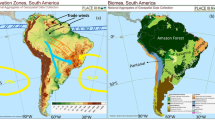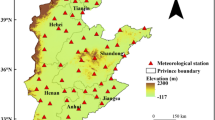Abstract
On the basis of climate zones classified by the number of days of the daily average temperature ≥ 10 °C (DT10) over China, the performance of the 9 CMIP5 climate models is evaluated in this paper. The results indicate that the CMCC-CMS and MPI-ESM-MR show higher skill than the other 7 models in simulating spatial pattern and its decadal change of climate zones over China. The simulation results for FGOALS-g2 and INM-CM4 both show relatively lower skill than the other 7 models. Meanwhile, the performance of multi-model ensemble in simulating climate zones over China is obviously better than the simulated result of any single model. So, it is a good way to simulate climate zones by multi-model ensemble to reduce some uncertainty of climate models. However, it is crucial to select appropriate ensemble members. Compared with 1960–2005, the climatic zones in China have an obvious trend of northward shift in 2021–2100. The range of southern sub-tropical belt expands to the most areas in the south of Yangtze River under RCP4.5 emission scenarios, and further extends to the north areas of Yangtze River with a maximum of 2–6° of latitude under RCP8.5 emission scenarios. Middle sub-tropical belt shifts gradually to the areas between Yellow River and north areas of the middle and lower reaches of the Yangtze River. Northern sub-tropical belt shifts northward to southeastern North China. Warm extra-tropical belt extends to the most of Northeast China, most of central Inner Mongolia, and northern Xinjiang under RCP8.5 emission scenarios.
















Similar content being viewed by others
References
Bunkers MJ, Miller JR, DeGaetano AT (1996) Definition of climate regions in the Northern Plains using an objective cluster modification technique. J Clim 9:130–146
Chan D, Wu QG, Jiang GX, Dai XL (2016) Projected shifts in koppen climate zones over China and their temporal evolution in CMIP5 multi-model simulations. Adv Atmos Sci 33(3):283–293
Chang JH (1955) The climate of China according to the new Thornthwaite classification. Ann Assoc Am Geogr 45:393–403
Chen XJ (1982) A new approach to the climate division of China. Acta Meteorologica Sinica 40:35–48 (in Chinese)
Ding RQ, Li JP (2009) Decadal and seasonal dependence of North Pacific SST persistence. J Geophys Res 114:D01105. https://doi.org/10.1029/2008JD010723
Ding RQ, Feng GL, Liu SD, Liu SK, Huang SX, Fu ZT (2006) Review of the study of nonlinear atmospheric dynamics in China (2003–2006). Adv Atmos Sci 24:1077–1085
Ding Y, Ren G, Zhao Z, Xu Y, Luo Y, Li Q, Zhang J (2007) Detection, causes and projection of climate change over China: an overview of recent progress. Adv Atmos Sci 24:954–971
Ding RQ, Ha K-J, Li JP (2010) Interdecadal shift in the relationship between the East Asian summer monsoon and the tropical Indian Ocean. Climate Dyn 34:1059–1071
Ding RQ, Li J, Tseng YH, Ha KJ, Zhao S, Lee JY (2016) Interdecadal change in the lagged relationship between the Pacific–South American pattern and ENSO. Clim Dyn. https://doi.org/10.1007/s00382-016-3002-1
Domros M, Peng G (1988) The climate of China. Springer, Berlin, 360 pp
Dong JW, Liu JY, Zhang GL, Basara JB, Greene S, Xiao XM (2013) Climate change affecting temperature and aridity zones: a case study in Eastern Inner Mongolia, China from 1960 to 2008. Theor Appl Climatol 113:561–572
Elguindi N, Grundstein A, Bernardes S, Turuncoglu U, Feddema J (2014) Assessment of CMIP5 global model simulations and climate change projections for the 21st century using a modified Thornthwaite climate classification. Clim Change 122:523–528
Feddema JJ (2005) A revised Thornthwaite-type global climate classification. Phys Geogr 26:442–466
Feng J, Li JP, Zhu JL, Li F, Sun C (2015) Simulation of the equatorially asymmetric mode of the Hadley circulation in CMIP5 models. Adv Atmos Sci 32(8):1129–1142. https://doi.org/10.1007/s00376-015-4157-0
Feng J, Li JP, Zhu JL, Liao H, Yang Y (2017) Simulated contrasting influences of two La Niña Modoki events on aerosol concentrations over eastern China. J Geophys Res: Atmos 122, https://doi.org/10.1002/2016JD026175
Fovell RG (2010) Consensus clustering of US temperature and precipitation data. J Clim 10:1405–1427
Fraedrich K, Gerstengarbe FW, Werner PC (2001) Climate shifts during last century. Clim Change 50:405–417
Giorgi F, Bi XQ, Qian Y (2003) Indirect vs. direct effects of anthropogenic sulfate on the climate of East Asia as simulated with a regional coupled climate-chemistry/aerosol model. Clim Change 58:345–376
Grigg D (1965) The logic of regional systems. Ann Assoc Am Geogr 55:465–491
Hanf FS, Zittel J, Spangehl T, Cubasch U (2012) Shifts of climate zones in multi-model climate change experiments using the Köppen climate classification. Meteorologische Z 21:111–123
Haurwitz B, Austin JM (1944) Climatology. McGraw-Hill
Huang JP, Ji MX, Xie Y, Wang S, He Y, Ran J (2016a) Global semi-arid climate change over last 60 years. Clim Dyn 46:1131. https://doi.org/10.1007/s00382-015-2636-8
Huang JP, Yu HP, Guan XD, Wang GY, Guo RX (2016b) Accelerate dryland expansion under climate change. Nat Clim Change 6:166–171. https://doi.org/10.1038/nclimate2837
Jiang YD, Wang SY, Yang S, Dong WJ, Fu CB, Zhao TB (2008) Future trends of climatic belts and seasons in China. Int J Climatol 28:1483–1491. https://doi.org/10.1002/joc.1658
Köppen W (1900) Attempted climate classification in relation to plant distributions. Geogr Z 6:657–679
Kottek M, Grieser J, Beck C, Rudolf B, Rubel F (2006) World map of the Köppen climate classification updated. Meteorol Z 15:259–263
Kumar S, Merwade V, Kinter JL, Niyogi D (2013) Evaluation of temperature and precipitation trends and long-term persistence in CMIP5 twentieth-century climate simulations. J Clim 26(12):4168–4185
Li MX, Ma ZG (2014) Soil moisture-based study of the variability of dry-wet climate and climate zones in China. Chin Sci Bull 58:531–544. https://doi.org/10.1007/s11434-012-5428-0
Li JP, Zeng QC (2002) A unified monsoon index. Geophys Res Lett 29:1274. https://doi.org/10.1029/2001GL013874
Li JP, Zhang L (2009) Wind onset and withdrawal of Asian summer monsoon and their simulated performance in AMIP models. Clim Dyn 32:935–968. https://doi.org/10.1007/s00382-008-0465-8
Li JP, Wu ZW, Jiang ZH, He JH (2010) Can global warming strengthen the East Asian summer monsoon? J Clim 23:6696–6705
Li JP, Sun C, Jin FF (2013) NAO implicated as a predictor of Northern Hemisphere mean temperature multidecadal variability. Geophys Res Lett 40:5497–5502. https://doi.org/10.1002/2013GL057877
Lohmann U, Sausen R, Bengtsson L, Cubasch U, Perlwitz J, Roeckner E (1993) The Köppen climate classification as a diagnostic tool for general circulation models. Clim Res 3:177–193
Mahlstein I, Daniel J, Solomon S (2013) Pace of shits in climate regions increases with global temperature. Nat Clim Change 3(8):739–743
Mihailović DT, Lalić B, Drešković N, Mimić G, Djurdjević V, Jančić M (2015) Climate change effects on crop yields in Serbia and related shits of Köppen climate zones under the SRES-A1B and SRES-A2. Int J Climatol 25:3320–3334
Ni J (2011) Impacts of climate change on Chinese ecosystems: key vulnerable regions and potential thresholds. Reg Environ Change 11:49–64
Phillips TJ, Bonfils CJW (2015) Köppen bioclimatic evaluation of CMIP historical climate simulations. Environ Res Lett 10:064005
Pielke RA, Pitman A, Niyogi D et al. (2011) Land use/land cover changes and climate: Modeling analysis and observational evidence. WIREs Clim Change 2, 828–850, https://doi.org/10.1002/wcc.144
Rubel F, Kottek M (2010) Observed and projected climate shifts 1901–2100 depicted by world maps of the Köppen-Geiger climate classification. Meteorol Z 19:135–141
Sha WY, Shao XM, Huang M (2002) Climate warming and its impact on natural regional boundaries in China in the 1980s. Sci China 45(12):1099–1113
Shi Y, Gao XJ, Wu J (2012) Projected changes in Köppen climate types in the 21st century over China. Atmos Oceanic Sci Lett 5:495–498
Smith GL, Wilber CA, Gupta SK, Stackhouse JRPW (2002) Surface radiation budget and climate classification. J Clim 15:1175–1188
Sun YL, Yan XD, Xie DT (2008) A new method of vegetation-climate classification in China. Int J Climatol 28:1163–1173
Sun C, Li JP, Jin FF (2015) A delayed oscillator model for the quasi periodic multidecadal variability of the NAO. Clim Dyn. https://doi.org/10.1007/s00382-014-2459-z
Sylla MB, Elguindi N, Giorgi F, Wisser D (2016) Projected robust shift of climate zones over West Africa in response to anthropogenic climate change for the late 21st century. Clim Change 134:241–253
Tang BQ, Yan JP, Li YJ (2015) Changes of the accumulated temperature above 10 °C in East China. Chin J Agrometeorol 36(6):674–682
Taylor KE, Stouffer RJ, Meehl GA (2012) An overview of CMIP5 and the experiment design. Bull Am Meteorol Soc 93:485–498. https://doi.org/10.1175/BAMS-D-11-00094.1
Terjung WH (1970) Toward a climate classification based on net radiation. Proc Assoc Am Geogr 2:140–144
Thornthwaite CW (1948) An approach toward a rational classification of climate. Geogr Rev 38:55–94
Trewartha GT, Horn LH (1980) An introduction to climate. McGraw-Hill
Tu C (1948) Koppen’s climate classification in China. Acta Meteorol Sin 14:51–67 (in Chinese)
Wu SH, Zheng D, Yin YH, Lin ED, Xu YL (2010) Northward-shift of temperature zones in China’s eco-geographical study under future climate scenario. J Geogr Sci 20(5):643–651
Xiao D, Li JP (2007) Spatial and temporal characteristics of the decadal abrupt changes of global atmosphere-ocean system in 1970s. J Geophys Res 112:D24S22, https://doi.org/10.1029/2007JD008956
Xiao D, Li JP, Zhao P (2012) Four-dimensional structures and physical process of the decadal abrupt changes of the northern extratropical ocean-atmosphere system in 1980s. Inter J Climatol 32:983–994. https://doi.org/10.1002/joc.2326
Xing N, Li J, Wang LN (2016) Multidecadal Trends in Large-Scale Annual Mean SATa Based on CMIP5 Historical Simulations and Future Projections. J Clim. https://doi.org/10.1016/J.ENG.2016.04.011
Ye D, Dong WJ, Jiang YD (2003a) The northward shift of climatic belts in China during the last 50 years. IGBP News Letter 53:7–9
Ye D, Jiang YD, Dong WJ (2003b) The northward shift of climatic belts in China during the last 50 years and the corresponding seasonal responses. Adv Atmos Sci 20:959–967
Zhang XL, Yan XD (2014) Temporal change of climate zones in China in the context of climate warming. Theor Appl Climatol 115:167–175. https://doi.org/10.1007/s00704-013-0887-z
Zhang XL, Yan XD (2016) Deficiencies in the simulation of the geographic distribution of climate types by global climate models. Clim Dyn 46:2749–2757
Zhang XL, Yan XD, Chen ZJ (2017) Geographic distribution of global climate zones under future scenarios. Int J Climatol. https://doi.org/10.1002/joc.5089
Zheng JY, Bian JJ, Ge QS, Hao ZX, Yin YH, Liao YM (2013) The climate regionalization in China for 1981–2010. Sci Bull 58:3088–3099 (in Chinese)
Zhou TJ, Chen XL, Dong L, Wu B, Man WM, Zhang LX, Lin RP, Yao JC, Song FF, Zhao CB (2014a) Chinese contribution to CMIP5: an overview of five Chinese Models’ performances. J Meteorol Res 28(4):481–509
Zhou TJ, Zou LW, Wu B, Jin CX, Song FF, Chen XL, Zhang LX (2014b) Development of earth/climate system models in China: a review from the coupled model intercomparison project perspective. J Meteorol Res 28(5):762–779
Zhu K (1930) Research on climate regionalization of China. Geography Magazine 3 (in Chinese)
Zou LW, Zhou TJ (2015) Asian summer monsoon onset in simulations and CMIP5 projections using four Chinese climate models. Adv Atmos Sci 32(6):794–806
Acknowledgements
The authors would like to thank the anonymous reviewers and editors for the beneficial and helpful suggestions for this manuscript, and Wen Zhang for beneficial discussion. This research was jointly supported by National Natural Science Foundation of China (Grant Nos. 41775092, 41605069, 41475073, 41530531, and 41475064).
Author information
Authors and Affiliations
Corresponding author
Rights and permissions
About this article
Cite this article
He, Wp., Zhao, Ss., Wu, Q. et al. Simulating evaluation and projection of the climate zones over China by CMIP5 models. Clim Dyn 52, 2597–2612 (2019). https://doi.org/10.1007/s00382-018-4410-1
Received:
Accepted:
Published:
Issue Date:
DOI: https://doi.org/10.1007/s00382-018-4410-1




